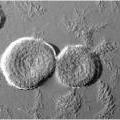
Photovoltaic cells for converting solar energy to
electricity work best if they have large internal surface areas between
electron donating and electron accepting materials to collect light-generated
charge. A collaboration between
researchers of the Liquid Crystal Materials Research (MRSEC) Center of the
University of Colorado, Boulder and the National Renewable Energy Laboratory
has found that networks of 20 nanometer diameter liquid crystal filaments do
this job very well. The image shows
micron diameter pancakes of liquid crystal nanofilaments arranged in spirals, forming a spongy network in which
efficient energy conversion takes place.